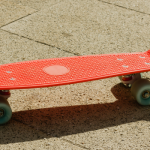Skateboard wheels, typically made from a type of rubber known as polyurethane, are designed to withstand significant friction and heat generated during rides.
However, they are not completely immune to melting. Under extremely high temperatures and prolonged exposure, skateboard wheels can indeed melt or deform.
This phenomenon is relatively rare and usually occurs under conditions that are far beyond the normal operating environment of a skateboard.
Therefore, while it’s possible, it’s highly unlikely you’ll ever see your skateboard wheels melt during your regular rides.
Composition of Skateboard Wheels
Skateboard wheels are typically made from polyurethane, a versatile polymer known for its durability, flexibility, and resistance to abrasion.
This material provides the necessary combination of hardness and grip required for smooth rides and effective maneuverability on various surfaces.
Polyurethane is chosen for skateboard wheels due to its ability to withstand the wear and tear associated with skateboarding activities.
It’s an ideal material for maintaining a balance between hardness and shock absorption, crucial for a comfortable and controlled ride.
Melting Point of Polyurethane
To determine whether skateboard wheels can melt, it’s essential to understand the melting point of polyurethane.
Polyurethane has a relatively high melting point, typically ranging from 320 to 350 degrees Fahrenheit (160 to 177 degrees Celsius).
This means that under normal skateboarding conditions, which involve friction with surfaces and exposure to ambient temperatures, the wheels are unlikely to reach temperatures high enough for melting.
Factors Influencing Skateboard Wheel Integrity
While the melting point of polyurethane is well above the temperatures encountered during regular skateboarding, certain factors can influence the integrity of skateboard wheels:
Friction and Heat Generation:
Friction is a crucial aspect of skateboarding, as it provides the necessary traction for riders to control their boards.
However, excessive friction between the skateboard wheels and the riding surface can generate heat.
This heat is a byproduct of the molecular interactions between the wheel material (polyurethane) and the ground.
High speeds, prolonged slides, or rough surfaces can contribute to increased friction, resulting in localized heating of the wheels.
While this heating is unlikely to reach the melting point of polyurethane, it can lead to a phenomenon known as “coning” or uneven wear, affecting the wheel’s performance and durability over time.
External Heat Sources:
Skateboards are often exposed to various environmental conditions, and prolonged exposure to direct sunlight or contact with hot surfaces can impact the integrity of skateboard wheels.
Polyurethane, while resilient, can undergo processes like thermal degradation when exposed to elevated temperatures over extended periods.
Continuous exposure to high temperatures, such as those experienced on scorching days or when left in direct sunlight for extended periods, may lead to a gradual breakdown of the polyurethane material.
However, outright melting is still unlikely, and the primary concern is the accelerated degradation of the wheel’s properties, including hardness and elasticity.
Excessive Speed and Sliding:
High-speed slides and prolonged sliding maneuvers are common in skateboarding, especially in disciplines like downhill or freeride.
While these actions contribute to the excitement of the sport, they also generate substantial heat due to increased friction between the wheels and the riding surface.
The heat generated during high-speed slides can lead to accelerated wear and tear on the wheels.
It’s important to note that, under normal circumstances, the temperatures reached during these activities are not sufficient to cause polyurethane to melt.
However, the cumulative effect of repeated high-speed sliding can impact the longevity and performance of the wheels over time.
Poor Quality or Counterfeit Wheels:
The quality of skateboard wheels is paramount to their performance and durability. Poor-quality or counterfeit wheels may not be made from genuine polyurethane, the preferred material for its optimal combination of hardness and flexibility.
Inferior materials may lack the necessary resilience and resistance to wear, leading to unpredictable performance under stress.
In such cases, the wheels may wear out quickly, deform, or exhibit other undesirable characteristics.
Choosing reputable brands and ensuring the authenticity of skateboard wheels is essential for the safety and satisfaction of the rider, as low-quality materials may not withstand the demands of skateboarding and may be more prone to deformation or failure under stress.
Conclusion
Skateboard wheels made from genuine polyurethane are highly resistant to melting under normal skateboarding conditions.
The melting point of polyurethane is well above the temperatures typically encountered during routine rides.
However, factors such as excessive friction, external heat sources, and poor-quality materials can influence the integrity and longevity of skateboard wheels.
To ensure optimal performance and safety, it’s crucial for skateboarders to choose high-quality wheels and be mindful of factors that may contribute to wear and tear over time.
![Why do skateboarders hate scooters? [Reasons + Tips] Why do skateboarders hate scooters? [Reasons + Tips]](https://bedoper.site/wp-content/uploads/2023/04/Why-do-skateboarders-hate-scooters-150x150.png)


![How fast do skateboards go downhill? [90 mph (145 km/h)] How fast do skateboards go downhill? [90 mph (145 km/h)]](https://bedoper.site/wp-content/uploads/2023/04/How-fast-do-skateboards-go-downhill-150x150.png)
